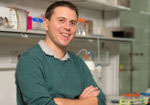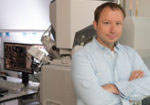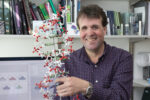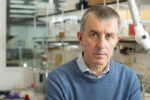N-to-S
Kelly Nguyen
LMB Division - Structural Studies
Molecular mechanism of telomere maintenance
The ends of linear eukaryotic chromosomes are capped telomeres, an array of long telomeric repeat tracts ([TTAGGG]n in human) bound by telomeric protein factors. More…
John O'Neill
LMB Division - Cell Biology
Cellular rhythms, signalling and metabolic regulation
Circadian (approximately daily) rhythms are cell-intrinsic phenomena that permeate every level of biology, and thereby impact upon many aspects of health and disease. More…
Lori Passmore
LMB Division - Structural Studies
Molecular Machines that regulate gene expression
Eukaryotic genes are normally transcribed as pre-mRNAs that must be processed before they are exported from the nucleus and translated into proteins. The pre-mRNA is cleaved and a poly(A) tail is added to its 3'end. More…
Lalita Ramakrishnan
LMB Division - Cell Biology
Mechanisms of tuberculosis pathogenesis
TB remains a major cause of death despite a live attenuated vaccine (BCG) for a century and effective antibiotics for 60 years. TB’s persistence over millennia in the face of these major medical advances underscores the ability of Mycobacterium tuberculosis to evade and exploit host defenses and antibiotics. More…
Felix Randow
LMB Division - Protein and Nucleic Acid Chemistry
Cell-autonomous and innate immunity
We are interested in cell autonomous innate immunity, i.e. in the ability of individual cells to defend themselves against infection. More…
Jing Ren
LMB Division - Neurobiology
Developmental assembly of the serotonin system
The serotonin (5HT) system is believed to be the most expansive neural system, innervating nearly every area of the brain and has been implicated in the modulation of seemingly every human behavior. It is the most frequently targeted neural system pharmacologically for treating psychiatric disorders, including depression and anxiety. More…
Wes Robertson
LMB Division - Protein and Nucleic Acid Chemistry
Synthetic Genomics for Microbiome Reprogramming
Synthetic biology enables us to control certain genetic programs and introduce novel phenotypes in model bacteria such as E. coli, though as a field we lack the ability to comprehensively engineer the bacteria we know significantly affect human health. The Robertson lab develops genome engineering tools for the de novo synthesis of non-model gut bacteria, with the ultimate aim of reprogramming the microbiome to study and modulate human health. More…
Noe Rodriguez
LMB Division - Protein and Nucleic Acid Chemistry
Investigation of immunity and neuro-immune modulation in infection and cancer
Signalling between neurons and immune cells regulates many physiological processes and is critical for immunity against tumours and infectious microbes. The underlying cellular and molecular mechanisms mediating this communication are mostly unknown. More…
Christopher Russo
LMB Division - Structural Studies
Imaging the atomic structure of biological molecules by electron cryomicroscopy
Many of the outstanding questions in biology and medicine are difficult to address because there is no way to directly look at the complex molecular machines responsible for life. We work on developing new instruments and methods for imaging biological molecules, (DNA, RNA and proteins), at atomic resolution. More…
Benjamin Ryskeldi-Falcon
LMB Division - Neurobiology
Pathological protein assembly in neurodegenerative diseases
Ordered assembly of a small number of proteins within neurons and, in some cases, glia is a feature of neurodegenerative diseases. These proteins form amyloid structures enriched in repetitively stacked beta-strands. More…
Julian Sale
LMB Division - Protein and Nucleic Acid Chemistry
Vertebrate mutagenesis
We wish to understand the mechanisms that alleviate replication arrest following DNA damage and their consequences for the formation of mutations, the driving force in the development of cancer. More…
William Schafer
LMB Division - Neurobiology
Cellular and molecular mechanisms of behaviour
Elucidating the mechanisms by which nervous systems process information and generate behaviour is among the fundamental problems of biology. Ultimately, it is desirable to understand these processes at the most basic level, that of molecules and cells. More…
Sjors Scheres
LMB Division - Structural Studies
Structural biology of neurodegeneration
We are intrigued by how proteins work. The genetic code determines the amino acid sequence of proteins, which in turn determines their 3D-structure. The precise 3D-arrangement of different types of atoms inside proteins allows them to perform the many types of functions that are needed to keep the cell alive. More…
Marta Shahbazi
LMB Division - Cell Biology
Cell fate decisions in the early mammalian embryo
Pluripotent stem cells have the unique capacity to generate all the cell types of the organism. In the embryo, they undergo concomitant changes in shape and identity to set the foundation of the body plan. More…
John Sutherland
LMB Division - Protein and Nucleic Acid Chemistry
Chemical origins of molecular biology
A true understanding of biology must include knowledge of its chemical origins, and comprehending the chemical events that gave biology its foundations - cellular format, the central dogma, the genetic code - is therefore a fundamental aspect of natural science. More…














